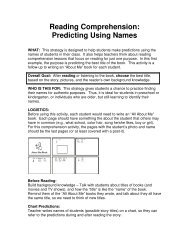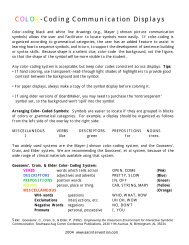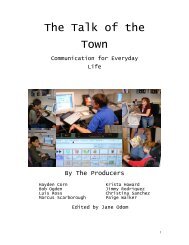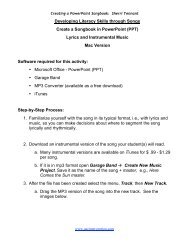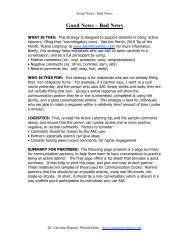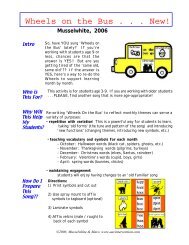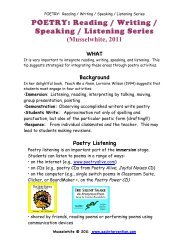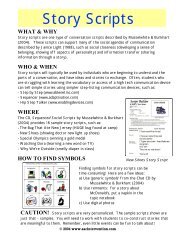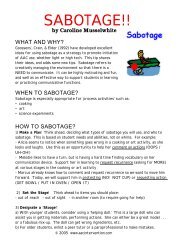Comprehension Checklist - AAC Intervention.com
Comprehension Checklist - AAC Intervention.com
Comprehension Checklist - AAC Intervention.com
You also want an ePaper? Increase the reach of your titles
YUMPU automatically turns print PDFs into web optimized ePapers that Google loves.
<strong>Comprehension</strong> <strong>Checklist</strong><br />
WHY:<br />
This simple checklist can be used as a pre-post measure. It will support<br />
teachers and professionals by:<br />
1) Documenting student progress (use a different color marker each<br />
time)<br />
2) Reminding adults of sample targets for <strong>com</strong>prehension support<br />
3) Showing areas of strength and weakness for both individuals and<br />
classes<br />
WHO:<br />
This checklist may be useful for parents, teachers, or speech-language<br />
pathologists. It is intended for use with anyone who struggles with reading<br />
<strong>com</strong>prehension, or listening <strong>com</strong>prehension for text.<br />
HOW:<br />
Use this as a pre-post checklist for an individual student or for a group of<br />
students. Ideally, it should be used as follows:<br />
1) Document student performance by using this three times per year<br />
(beginning, middle, and end), using a different color marker each time.<br />
2) Use the information to <strong>com</strong>pare performance across the year<br />
3) Use the information to identify targets for scaffolding reading<br />
<strong>com</strong>prehension, such as building text-to-text connections and listening<br />
for key story settings.<br />
4) Idea: Import the checklist into an app such as Noteability which<br />
permits you to write directly on the document, using different colored<br />
markers.<br />
RESOURCES: More Information About Scaffolding <strong>Comprehension</strong><br />
Cunningham, P., & Allington, R. (2010). Classrooms that work: They can all read and<br />
write, 5 th Edition. Pearson Allyn & Bacon: ISBN: 0137048378.<br />
Erickson, K. and Koppenhaver, D. (2007) Children with Disabilities: Reading and<br />
Writing the Four-Block Way®. Greensboro, NC: Carson-Dellosa. www.donjohnston.<strong>com</strong><br />
Tierney, R. J., and J. W. Cunningham. (1984). "Research on teaching reading<br />
<strong>com</strong>prehension." In Pearson, P., Handbook of reading research. New York: Longman.<br />
0582281199.<br />
© 2013 Dr. Caroline Ramsey Musselwhite www.aacintervention.<strong>com</strong>
<strong>Comprehension</strong> <strong>Checklist</strong><br />
Student: ____________ Teacher:___________<br />
Date 1: _________ Date 2: ___________ Date 3: _________<br />
Circle One: Listening <strong>Comprehension</strong> Reading <strong>Comprehension</strong><br />
Vocabulary<br />
Student identifies key story vocabulary.<br />
0 1 2 3 4 5<br />
Prediction<br />
Student makes reasonable predictions and backs them up.<br />
0 1 2 3 4 5<br />
Story Elements<br />
Student can remember important story characters.<br />
0 1 2 3 4 5<br />
Student can describe story characters, and connect descriptions to book<br />
pages.<br />
0 1 2 3 4 5<br />
Student can identify story settings, and show where they are in the book.<br />
0 1 2 3 4 5<br />
Student can identify feelings of main character throughout the book and<br />
refer to the book to support answer.<br />
0 1 2 3 4 5<br />
Text to Self / Text to Text<br />
Student can connect own life to that of characters.<br />
0 1 2 3 4 5<br />
Student can connect elements between two stories.<br />
0 1 2 3 4 5<br />
Key: 0 = Not at all 1 = Beginning understanding 2= Struggles<br />
3 = Occasionally successful 4 = Often successful 5 = Mastered skill<br />
Comments:<br />
© 2013 Dr. Caroline Ramsey Musselwhite www.aacintervention.<strong>com</strong>



